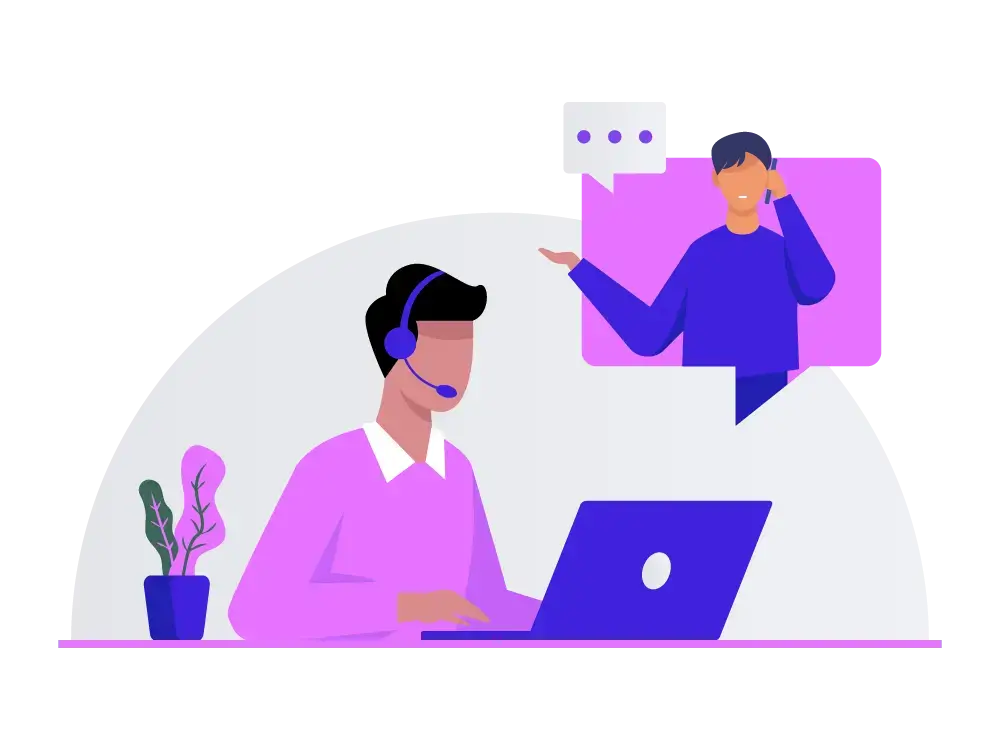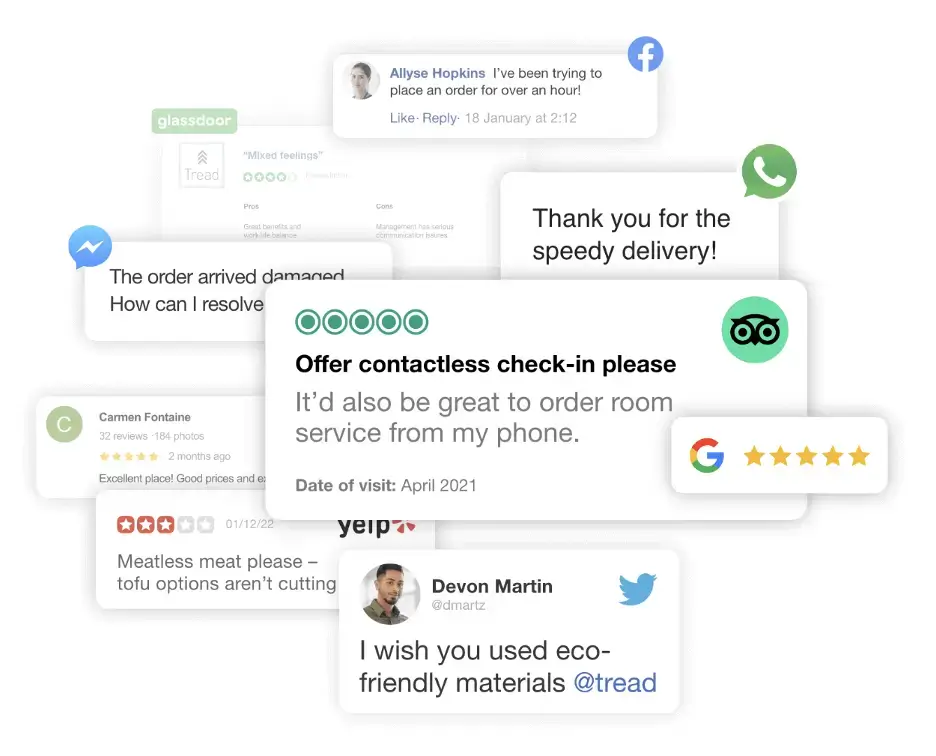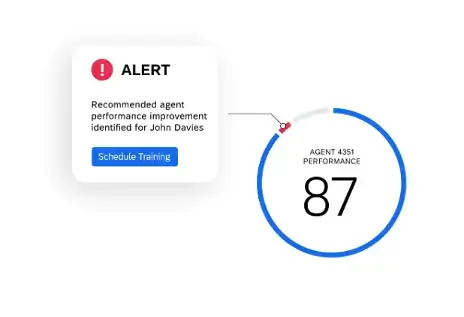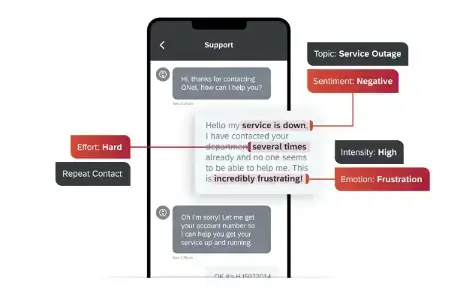Author: Adam Bunker
Subject Matter Expert: Brandon Hanson
Business success is reliant upon your customers and the experiences they have. When customers have incredible experiences with your brand, the resulting customer satisfaction makes them far more likely to return and spend more. But a single bad experience can be devastating – and have long-lasting effects on customer retention.
Naturally, the goal here is to reduce bad experiences by driving actions across product, brand, and customer success teams that preserve that relationship with the customer, and ultimately mitigate risk to the business.
85% of consumers say it only takes one bad customer experience for them to stop doing business with a company. The thing is, more than 70% of customer interactions occur within the customer care team – and that makes the contact center both a vital area of focus for customer experience and a hotbed of information that can make an organization smarter.
Support calls, chats, customer emails, and social media posts all provide deep insight into the customer experience, uncovering experience gaps that can have a detrimental impact on long-term business success.
But to understand the benefit that great customer care has on the business, we need to outline what we mean when we use the term “customer care” in the first place.
Free eBook: 2025 global consumer trends report
What is customer care?
Customer Care includes all aspects of the customer experience post-sale – including support, help, and maintenance. For some organizations, this may include upsell opportunities as well. Some contact centers undertake aspects of pre-sale work (in addition to upselling of existing customers) but customer care is not typically seen as tying into the sales cycle.
Customer care also includes digital channels (non-human interaction) like FAQs on the website and self-service portals (e.g. for account self-management), and may include AI chatbots too. Live customer care interactions involve calling into a contact center, chatting with a live agent, or emailing. It may even include a visit to a branch or store, or an onsite visit from a technician/engineer.
Customer care vs customer experience
Customer experience is seen by many as the last source of sustainable differentiation, and having engaged frontline employees is key to delivering the best experience for customers – which is where significant value in this differentiation can be created.
Customer experience is not only the responsibility of your frontline employees but is inclusive of the experience customers have with the products and services they purchase. For example, the experience of ordering your dream car may be a special one, but it’s undone if the car breaks down two months later.
But there is one thing that connects the two: the customer. Understanding their needs is critical to maintaining and increasing customer lifetime value.
Consumers want personalized and consistent customer experiences. In fact, 73% of customers will walk away from your brand if they don’t get a consistent experience across all touchpoints
Customer care vs contact center
You may hear the term “contact center” used interchangeably when discussing aspects of customer care, but it should be noted that contact center and customer care are different. This is because the contact center is the human-powered element of customer care – and is therefore a vital part of customer care.
Contact centers are internal departments or outsourced businesses to which phone calls, live chats, emails, and social media contacts from current and potential customers are directed. They handle inbound and/or outbound contacts.
Given the broad nature of these services, virtually every industry is represented in the contact center market, including utilities, hospitality, telecommunications, finance, and retail.
More and more, businesses and consumers who approach contact centers demand enhanced, productive, and seamless end-to-end customer experiences across multiple channels. They expect the customer care agents to know who they are, what they’ve purchased, and what the issue is without having to explain it numerous times.
With the increase in the use of artificial intelligence and more reliance on customer self-service tools (such as chatbots and Interactive Voice Response (IVR) recordings), it is critical for organizations to better understand and monitor the quality of their contact center interactions, and to put the infrastructure and tools in place to be able to personalize those experiences.
That way businesses can ensure the highest level of performance on the factors that drive excellent customer experiences and, in turn, customer satisfaction
Customer care vs customer service
Customer service is an important part of delivering excellent customer care, and the broader customer experience. Customer interactions are typically judged or referred to by the level of ‘service’ given – “Was the service good?” This level of service may determine the customer’s entire experience.
Customer service usually covers refunds/refunds and support (e.g. tech or product support). The customer service team also handles complaints. This is sometimes referred to as “customer relations”, and these hold the same meaning, even though customer relations is a bit of an outdated term.

Elements of customer care
While there are various elements to customer care, the ones you’ll use in your customer care center will vary depending on the industry that your business is in, and what elements are needed to suit your business size/needs.
The elements of customer care are not all equal in terms of cost, and so whilst the outcome of customer care should be to add to or improve the customer experience, operational costs need to be considered too.
As a rule, the best customer care centers deal with simple, everyday queries in ways that have a minimal cost to the business – i.e. through self-service – as this allows your most prized resource – your people, agents, staff – to deal with priority issues effectively.
The elements of customer care include:
(From most expensive interactions to least)
Field service / on-site visit: This is where a member of staff will visit a business or home to offer a particular service. This might be to fix your satellite TV, build your new Peloton bike, or fix your car because it has broken down.
In-branch / in-store: When a customer comes to your branch or store to use a particular service. For example, going into a bank branch to discuss renewing their mortgage.
Phone call: Customers are routed through to agents in a contact center who can resolve their issues. The best customer care teams free up agent time and resources through self-service, so they can focus on the priority issues and make the best use of their time.
Live chat: Rather than calling up, customers can choose to solve their problems through a live (text) chat platform. These can have high satisfaction rates, and agents can even handle two to three conversations at one time.
Chatbot: An automated self-service feature, chatbots can answer everyday questions so agents don’t have to.
User forums (peer-to-peer support): A space for users to share problems and solutions.
Self-service portal: Manage your own accounts, without help from an agent. For example, this might be a bank account portal for you to check your bank balance, transfer money, or make a payment.
FAQs/Help pages: This is the first line of defense in your customer care program. These pages can divert traffic away from your contact center and solve simple, everyday queries.
In most cases, a customer with a simple query (‘How do I return this item?’) is best directed to FAQ pages, or perhaps a self-service ‘my account’ portal to check your latest account balance. Organizations should seek to automate many of these interactions as they are typically low value, repetitive, and can be solved more quickly this way – and this drives greater customer satisfaction because they won’t have to wait to speak to an agent.
Diverting these queries also helps you to build a resilient contact center. When you experience surges in demand that weren’t or couldn’t be planned for, self-service channels are your first line of defense.
However, for a complex query, a customer may be frustrated by automated responses from a chatbot, or from browsing multiple FAQ pages, and will be much more satisfied with human interaction – via live chat in an app, on the website, or a phone call with an agent.
A successful customer care program blends humans with technology, knowing the best use case for each. The right technology can help us adopt new processes, improve resolution times, and deliver better experiences for customers – but none of this is possible without the human element at the heart of it.
And crucially, not everything can – or should – be automated. Certain parts of your customer care program will require staff, and these can be found below:
- Digital team
- Social media team
- Contact center agents
- Branch/store staff
- Field service staff
AI in customer care
Effective customer care touches a myriad channels and touchpoints – and the onus is on the contact center to bridge the gap between them. Artificial intelligence is increasingly employed to help manage this task, since it’s great at absorbing interactions at a huge scale, parsing them for sentiment and meaning, and tying typically disparate channels together.
Many customer care AI solutions use natural language processing (NLP) to get to the heart of customer queries – and they can do so across calls, emails, texts, IMs, social media posts and reviews at once.

That’s alongside putting AI solutions to work in self-serve solutions like chatbots, where customers can get interactive aid in situations that don’t require a human customer service agent.
The benefits of all these abilities are huge in terms of improving your overall customer care proposition:
1. Unlimited listening
Human agents can only monitor through so many interactions. But with an NLP AI system embedded into the contact center, every channel – owned and third-party – can be scoured, sifted through and analyzed for customer conversations. That means a much more accurate impression of customer opinions, as well as the ability to flag issues and queries that might otherwise be missed.
2. Trend and pain point analysis
If you can bring information from every touchpoint into one place, you’re much more likely to be able to spot emerging issues – and work to fix them – than if you’re trying to manually analyze feedback.
3. Customer history and context
Customers expect not to have to repeat themselves as they move from channel to channel on their customer care journey. AI solutions that span touchpoints can help businesses build a cohesive, unified view of each customers’ history, letting them offer a more seamless omnichannel customer service.
4. Real-time prompts
That same contextual and holistic understanding of customer history can be used to provide agents with real-time prompts that deliver empathy and understanding. That’s alongside suggesting personalized discounts or compensation that will resonate with each specific customer – and drive up customer satisfaction in the process.
5. Agent coaching
AI tools in the contact center don’t just listen to customers. They also monitor agent performance – analyzing interactions for script compliance, empathy and issue resolution. The best tools can even use this information to automatically schedule coaching sessions.

6. Automating tasks
Agents typically lose a lot of valuable time to mundane tasks like post-call writeups. AI tools that understand everything that transpires can handle those time-consuming tasks, helping free up agents for the work they’re great at: speaking with customers.
7. Prioritisation
If you can offload some of the work in the contact center to AI tools, you can prioritize your customer care offering. Human agents are the powerhouse of your customer care program, so it’s important that they spend less time on low-priority queries and more time on the stuff that’s more difficult to unpick.
Customer care challenges
The key to unlocking effective customer care is challenging long-held misconceptions about its use, and embracing the value it can offer your business.
Budget constraint
Historically, contact centers and other customer care teams have been seen as a necessary overhead, where improvement efforts focus mainly on efficiency gains. That approach may drive down costs, but largely at the expense of the customer experience.
This thinking promotes a culture where agents rush to complete calls because they have a low target for average handle time (AHT), or they ‘cherry pick’ the easiest support issues to improve their resolution rate. The fallout comes when the more challenging queries end up taking the longest to get a response as multiple agents bypass them for easier queries to resolve.
Those targets are based on operational data – the data that tells us what’s happened in the past – and they offer little context for how customers have actually experienced the service. But we can change how we view customer care by acknowledging the role it has to play in the overall success of the businesses.
Workforce management
A focus on efficiency gains and targets based on unrealistic operational targets means that agent turnover can be very high. If the targets agents are judged upon don’t reflect the work they are doing, then agent engagement can be low because their work won’t be appreciated – and they don’t feel like they can affect change for their customers or the business.
There are wide-reaching ramifications for high agent turnover – businesses lose people with extensive product knowledge, with high replacement, training, and upskilling costs. It’s always more cost-efficient to invest in your existing staff.
Technology
A vision can’t become a reality if you don’t take steps to make it so. Technological deficiencies prevent some contact centers from delivering impactful experiences because they simply don’t have the systems in place to facilitate them. The most successful contact centers are connected to the whole business so everyone can work towards the same goal: delivering next-level customer satisfaction.
Benefits of great customer care
Moving towards a service-leadership approach and using Experience Data as part of an overall customer experience (CX) strategy is the key to changing how customer care is viewed. This moves customer care away from being seen as an overhead, positioning it instead as a key driver of positive customer experience – and a critical element of business success.
Benefits include:
- Improved customer loyalty / reduced churn – a positive customer experience means customers are more likely to return
- Improved brand perception – Meet your customers’ needs and not only will they have a positive perception of your brand, but they’re more likely to tell friends and family.
- Higher revenue / increased LTV – Higher customer loyalty, and more opportunities to upsell will increase your customer lifetime value and boost your bottom line.
Customer care can provide sources of data and information to help drive business decisions across the organization – offering feedback on products, identifying problems earlier, and helping understand where to direct investment.
The contact center is an important asset for achieving this because it is a goldmine of information that can make an organization smarter. Support calls, chat, customer emails, and social media, all provide deep insight into the customer experience, lead innovation across the business, and help uncover experience gaps that can have a detrimental impact on long-term business success.
Empowering your customer service representatives
How to deal with complaints
Experiences hinge on the key moments – the moments that matter, the make or break. These key moments have a high emotional load, and they mean a lot. When this goes wrong, how you respond is vital; if you can proactively limit any damage, you’ll strengthen the relationships you have with your customers.
There are three factors that determine how effectively you deal with complaints. These factors must transcend throughout the organization, from the customer team, to the product team, to the brand.
- Listening skills – The customer needs to feel heard, and their issues acknowledged. Showing the customer you are on their side can really help to disarm the situation.
- Knowledge – Listening to your customers is only effective if your staff has the knowledge to be able to help. The more knowledge your staff has about the customer’s journey, the product, and the context of the situation, the better staff can resolve customer issues and satisfy their needs.
- Empowerment – Just as your staff needs the knowledge to help, they need the power to help too. By making your staff solutions-focused they can solve customer issues before it’s too late. This empowerment needs to transcend throughout the business to make sure customer complaints are dealt with well.
Customer complaints are an important part of customer care because they signify something is going wrong in the customer journey.
These can be broken down into two categories:
- Closed loop (Inner Loop) – resolving specific customer issues on a 1:1 basis. This is a reactive measure. A customer complains, and the aim is to resolve that specific issue.
- Closed loop (Outer Loop) – strategic changes to customer care, e.g. MANY customers are hitting the same issue, so we seek to fix the system rather than keep resolving individual issues. This is more of a longer play, but is a proactive strategy to get ahead of potential issues.
Setting up your customer care team for success
Your people are your greatest asset. They have the ability to lighten moods, put a smile on someone’s face, and make a customer’s experience extra special.
Therefore you need to try and get the best out of them, make them feel rewarded, and work towards your business goals as a team. 70% of customer interactions happen in the contact center, so the risk to the business is high if experience gaps exist. Coaching and effectiveness are important factors in hunting down and fixing those gaps.
- Coaching – Use customer feedback to highlight areas where your staff can improve. This should be grounded in data, removing any potential for bias. By upskilling staff, you’ll make them more effective.
- Effectiveness – Consider changing the metrics on which you measure success, moving from operational benchmarks such as average call handling time, to metrics focused on outcomes – like how satisfied customers were at the end of the call, and how likely they are to come back.
As a result of these efforts, you’ll have happier, more productive staff. They’ll be willing to go further for the organization and be less likely to leave.
It’s more cost-efficient to retain staff than to replace them, while if you can keep your best staff, you’ll give customers better experiences and improve your customer retention rates – meaning you’ll spend less on acquiring new ones to fill that gap.
Feedback systems and programs to set up
Feedback programs should be set up to understand data in three ways – direct, indirect, and ambient. This is why the best programs bring together operational and experience data so that organizations can see the whole picture.
Direct feedback
This involves asking for feedback via a survey, through digital, in-app, email, interactive voice recordings (IVR), and chat channels.
You may use this technique to measure how well you are doing through metrics such as customer satisfaction score (CSAT) or Net Promoter Score (NPS), which signifies how likely someone is to recommend you.
Indirect feedback
This is feedback you gather from operational data, as you try to understand customer behavior. This includes analyzing:
- Bounce rates
- Time spent on page
- Abandoned calls
- Basket size
- First contact resolution ratio
- Product returns
- Renewal rates
- Internet of Things (IoT)
Why do we combine experience and operational data?
Asking a consumer for feedback directly will only reveal a limited amount of information. Insights will be primarily based on emotions, rather than tangible facts, and this makes it difficult to tie survey results back to operational data, such as order value or return rates.
By combining the two, we can see trends, better understand the pain points in the customer journey, and directly see the impact that experience has on business objectives. We can find the “why” behind the “what”, not just knowing what a customer does, but why they do it. This context helps us understand what drives these behaviors and puts organizations in a position to make better decisions that meet their needs. This will result in more positive outcomes for your business – because the experience is tied to financial metrics or transactional data.
IoT is an example of this. If you’re bypassing solicited customer feedback, then asking their unbiased, connected devices is the next logical step, enabling brands to uncover new information that gives customer experiences a deeper context.
Example: Disney’s MagicBand
One company doing this well is Disney. Their MagicBand, worn on the wrists of visitors to the Magic Kingdom, features a long-range radio that can be picked up by the company’s ‘queue management’ task force. The team can use this data to learn where customers are, what they are trying to do or see, and how long they have been waiting.
Such insights allow the team to take appropriate action (like deploying queue entertainment) to manage the experience, maximize the fun for customers, and ensure the overwhelming feeling isn’t “All we did is wait in line for two rides all day” – all using readily-available and easy to obtain data.
Tools you can use to improve customer care
Technology and human know-how make for a powerful combination in customer care – and should not be viewed as one another’s competition. Technology is here to facilitate better experiences, and humans play a pivotal role in achieving that. Whether you’re a large enterprise or small business, your customers demand great service.
Qualtrics® XM for Customer Experience™ helps you turn every customer interaction within your contact center into an opportunity and deliver the levels of service expected by your customers in the field, contact center, online, and in your stores.
By listening to customer feedback and understanding their needs your customer care teams will benefit from a single system that is built around taking action – action that quickly solves customer issues, betters their experience, and has a direct impact on the business by increasing customer satisfaction.

Qualtrics Frontline Care wraps all of these abilities up into one incredibly powerful package, helping customer care teams imbue their contact center with next-generation AI designed to compliment – rather than replace – human agents.
With Qualtrics, you’ll know exactly what drives each and every customer satisfaction score, what makes loyal customers tick, and what each customer service representative can do to improve – along with inbuilt social listening, natural language processing and task automation tools.
Free eBook: 2025 Global Consumer Trends Report